Mass adoption of electric vehicles (EV) is a key part of plans to decarbonize the United States’ energy system. As EV ownership in the U.S. increases, understanding how much EV owners are driving their cars informs everything from climate and energy models to U.S. policy and energy planning.
Thus far, the assumption among modelers and regulatory bodies like the Environmental Protection Agency (EPA) has been that EV owners drive their cars about the same number of miles as owners of gas vehicles. New research published in Joule, however, challenges that assumption and suggests we may be overestimating emissions savings from EVs.
In one of the largest studies on EV mileage to date, researchers at the George Washington University and the National Renewable Energy Laboratory examined odometer data from 12.9 million used cars and 11.9 million used SUVs between 2016 and 2022. They found that battery electric vehicle (BEV) cars were driven almost 4,500 fewer miles annually than gas cars.
The study found a gap for both cars and SUVs: electric cars had traveled 7,165 miles while gas-powered cars had traveled 11,642 miles annually, and electric SUVs traveled 10,587 miles while their gas-powered counterparts traveled 12,945 miles annually.
“People often assume that buying an EV is good for the environment, and it generally is, but the impacts scale with mileage,” John Helveston, study co-author and Assistant Professor of Engineering Management and Systems Engineering at GW, says. “Our study shows that the current generation of EV owners aren’t using them as much as gas cars. For maximum impact, we need the highest-mileage drivers behind the wheel of EVs rather than low-mileage drivers.”
Because EVs generally have lower emissions over their lifetime, replacing a higher-mileage gasoline vehicle with an EV results in larger emissions savings, all else being equal.
The researchers also compared miles traveled in Tesla versus non-Tesla BEVs, given Tesla’s prominence in the EV market and other features like higher-range vehicles and a well-established fast-charging network. Nonetheless, they found that while Teslas were driven more than other EVs, Teslas were still driven less than conventional gas cars. The study did show that plug-in hybrid and hybrid vehicles were driven similarly to gas vehicles, however.
The study has implications for policymakers and regulators who are drafting and implementing emissions regulations, as the findings challenge current assumptions about how far people are driving their electric vehicles. For example, the latest analysis from the EPA assumes EVs are already driven the same number of miles as conventional gas cars.
“If you’re going to craft a model that predicts how much emissions can be saved from EV adoption, that model heavily depends on how much you think EVs will be driven. If federal agencies are overestimating true mileage, that results in overestimating the emissions savings,” Helveston adds. “We need to better understand not just who is buying EVs, but how they’re driving them. What trips are EV owners substituting for a cleaner trip in an EV, and what trips are EV owners not taking?”
While not a focus of the study, Helveston suggested a couple of factors that may be affecting how far EV owners are driving their cars, including a lack of charging infrastructure that may limit EV owners’ ability to reliably take longer-distance trips. Researchers also suggest multi-vehicle households may be another reason behind these findings; people who own EVs often own multiple vehicles, and they may be spreading out their annual miles over each of them, resulting in lower overall mileage on the EV.
“The magnitude of data used in this study posed several technical challenges, but I hope our efforts can inform policy around the impacts of EV adoption,” said Lujin Zhao, a GW Ph.D. student who led the study.
The study’s findings also have implications for the electricity grid as it means the anticipated electricity consumption from EV adoption may be lower than utilities are planning for. Additionally, the researchers say it’s also important to consider that making a battery-powered EV typically results in higher upfront emissions compared to making a gasoline vehicle. Helveston and the research team says it will take longer to compensate for those higher up-front emissions if people aren’t driving the EV enough.
More information:
Lujin Zhao et al, Quantifying electric vehicle mileage in the United States, Joule (2023). DOI: 10.1016/j.joule.2023.09.015
Provided by
George Washington University
Citation:
New study finds electric vehicles are driven less than gas cars (2023, November 6)



